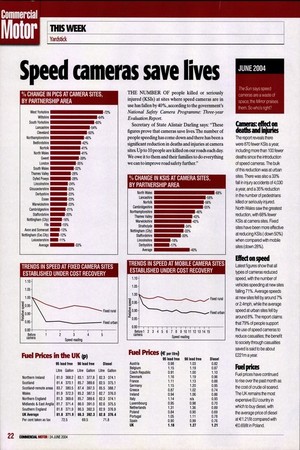Speed cameras save lives
Page 22

If you've noticed an error in this article please click here to report it so we can fix it.
THE NUMBER OF people killed or seriously injured (KSIs) at sites where speed cameras are in use has fallen by 40%, according to the government's National Safety Camera Programme: Three-year Evaluation Report.
Secretary of State Alistair Darling says: "These figures prove that cameras save fives. The number of people speeding has come down and there has been a significant reduction in deaths and injuries at camera sites. Up to 10 people are killed on our roads each day. We owe it to them and their families to do everything we can to improve road safety further?' Caner = effect on deaths and *ries
The report reveals there were 870 fewer KSIs a year, including more than 100 fewer deaths since the introduction of speed cameras. The bulk of this reduction was at urban sites. There was also a 33% fall in injury accidents of 4,030 a year, and a 35% reduction in the number of pedestrians killed or seriously injured. North Wales saw the greatest reduction, with 68% fewer KSIs at camera sites. Fixed sites have been more effective at reducing KSIs ( down 50%) when compared with mobile sites (down 28%). Med on speed
Latest figures show that all types of cameras reduced speed, with the number of vehicles speeding at new sites falling 71%. Average speeds at new sites fell by around 7% or 2.4mph, while the average speed at urban sites fell by around 8%. The report claims that 79% of people support the use of speed cameras to reduce casualties; the benef ft to society through casualties saved is said to be about £221m a year. Fuel prices
Fuel prices have continued to rise over the past month as the cost of crude oil soared. The UK remains the most expensive EU country in which to buy diesel, with the average price of diesel at €1.21/lit compared with €0.69/lit in Poland.


































































































































































































